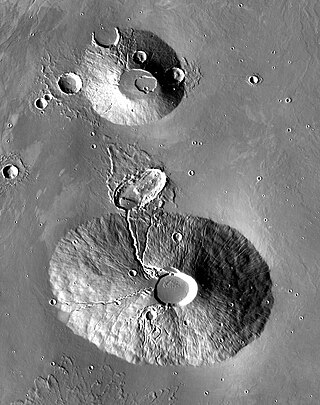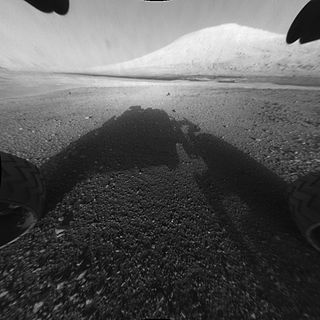
Mars Global Surveyor (MGS) was an American robotic space probe developed by NASA's Jet Propulsion Laboratory and launched November 1996. MGS was a global mapping mission that examined the entire planet, from the ionosphere down through the atmosphere to the surface. As part of the larger Mars Exploration Program, Mars Global Surveyor performed atmospheric monitoring for sister orbiters during aerobraking, and helped Mars rovers and lander missions by identifying potential landing sites and relaying surface telemetry.

NASA's Mars Exploration Rover (MER) mission was a robotic space mission involving two Mars rovers, Spirit and Opportunity, exploring the planet Mars. It began in 2003 with the launch of the two rovers to explore the Martian surface and geology; both landed on Mars at separate locations in January 2004. Both rovers far outlived their planned missions of 90 Martian solar days: MER-A Spirit was active until March 22, 2010, while MER-B Opportunity was active until June 10, 2018.

Areography, also known as the geography of Mars, is a subfield of planetary science that entails the delineation and characterization of regions on Mars. Areography is mainly focused on what is called physical geography on Earth; that is the distribution of physical features across Mars and their cartographic representations. In April 2023, The New York Times reported an updated global map of Mars based on images from the Hope spacecraft. A related, but much more detailed, global Mars map was released by NASA on 16 April 2023.

Hellas Planitia is a plain located within the huge, roughly circular impact basin Hellas located in the southern hemisphere of the planet Mars. Hellas is the third- or fourth-largest known impact crater in the Solar System. The basin floor is about 7,152 m (23,465 ft) deep, 3,000 m (9,800 ft) deeper than the Moon's South Pole-Aitken basin, and extends about 2,300 km (1,400 mi) east to west. It is centered at 42.4°S 70.5°E. Hellas Planitia spans the boundary between the Hellas quadrangle and the Noachis quadrangle.

Holden is a 140 km wide crater situated within the Margaritifer Sinus quadrangle (MC-19) region of the planet Mars, located with the southern highlands. It is named after American astronomer Edward Singleton Holden. It is part of the Uzboi-Landon-Morava (ULM) system.

The geology of Mars is the scientific study of the surface, crust, and interior of the planet Mars. It emphasizes the composition, structure, history, and physical processes that shape the planet. It is analogous to the field of terrestrial geology. In planetary science, the term geology is used in its broadest sense to mean the study of the solid parts of planets and moons. The term incorporates aspects of geophysics, geochemistry, mineralogy, geodesy, and cartography. A neologism, areology, from the Greek word Arēs (Mars), sometimes appears as a synonym for Mars's geology in the popular media and works of science fiction. The term areology is also used by the Areological Society.

Virrat is an impact crater on Mars, southwest of the crater Dinorwic and northeast of Clantas Fossae. Several Virrat crater radii to the north are the craters Koga and Nhill. It is named after Virrat, a town in Finland. According to a surface age map of Mars based on US Geological Survey data, the area around Virrat is from the Noachian epoch, which places the area's age at 3.8 to 3.5 billion years ago. At the highest point on its rim, it is about 6,400 metres (21,000 ft) above zero altitude, and it is about 5,100 metres (16,700 ft) at the crater bottom, giving it a depth of 1.3 kilometres (0.81 mi).

Tugaske is a Martian impact crater, approximately 31 kilometres (19 mi) in diameter. It is located at 32.1°S, 101.2°W, south of the crater Dinorwic and southeast of the crater Virrat. It is named after a town in Saskatchewan, Canada, and its name was approved by the International Astronomical Union in 1991. According to a surface age map of Mars based on US Geological Survey data, the area around Tugaske is from the Noachian epoch, which places the area's age at 3.8 to 3.5 billion years ago. The elevation around the rim averages about 6,700 metres (22,000 ft) above zero altitude, and the deepest part of the crater floor, in the central pit, measures 5,100 metres (16,700 ft) above zero altitude. The crater is therefore about 1.6 kilometres (0.99 mi) deep.

Koga is an impact crater on Mars, approximately 19 kilometers in diameter. It is located at 29.3°S, 103.8°W, north of the crater Virrat and northeast of the crater Dinorwic. To the north is the crater Nhill. It is named after a town in Tanzania, and its name was approved by the International Astronomical Union in 1991. According to a surface age map of Mars based on US Geological Survey data, the area around Koga is from the Noachian epoch, which places the area's age at 3.8 to 3.5 billion years ago. Sharp blocks and cliffs poke through a mantle of fine material located at the bottom of the crater. At the deepest part of the crater, it is about 5,200 meters in elevation above zero altitude, and its rim averages about 6,400 meters above zero altitude. It is therefore approximately 1.2 kilometers deep.

Srīpur is a Martian impact crater, approximately 22.99 kilometres (14.29 mi) in diameter. It is located at -31.1°S, 100.8°W, southeast of the crater Dinorwic and northeast of the crater Tugaske. It is named for Sripur, a town in Bangladesh, and its name was adopted by the International Astronomical Union in 1991.

Gale is a crater, and probable dry lake, at 5.4°S 137.8°E in the northwestern part of the Aeolis quadrangle on Mars. It is 154 km (96 mi) in diameter and estimated to be about 3.5–3.8 billion years old. The crater was named after Walter Frederick Gale, an amateur astronomer from Sydney, Australia, who observed Mars in the late 19th century. Mount Sharp is a mountain in the center of Gale and rises 5.5 km (18,000 ft) high. Aeolis Palus is the plain between the northern wall of Gale and the northern foothills of Aeolis Mons. Peace Vallis, a nearby outflow channel, 'flows' down from the hills to the Aeolis Palus below and seems to have been carved by flowing water. Several lines of evidence suggest that a lake existed inside Gale shortly after the formation of the crater.

The Diacria quadrangle is one of a series of 30 quadrangle maps of Mars used by the United States Geological Survey (USGS) Astrogeology Research Program. The quadrangle is located in the northwestern portion of Mars’ western hemisphere and covers 180° to 240° east longitude and 30° to 65° north latitude. The quadrangle uses a Lambert conformal conic projection at a nominal scale of 1:5,000,000 (1:5M). The Diacria quadrangle is also referred to as MC-2. The Diacria quadrangle covers parts of Arcadia Planitia and Amazonis Planitia.

The Mare Australe quadrangle is one of a series of 30 quadrangle maps of Mars used by the United States Geological Survey (USGS) Astrogeology Research Program. The Mare Australe quadrangle is also referred to as MC-30. The quadrangle covers all the area of Mars south of 65°, including the South polar ice cap, and its surrounding area. The quadrangle's name derives from an older name for a feature that is now called Planum Australe, a large plain surrounding the polar cap. The Mars polar lander crash landed in this region.

Ceraunius Tholus is a volcano on Mars located in the Tharsis quadrangle at 24.25° north latitude and 262.75° east longitude, part of the Uranius group of volcanoes. It is 130 kilometres (81 mi) across, approximately 8,500 metres (27,887 ft) high and is named after a classical albedo feature name.

Endeavour is an impact crater located in the Meridiani Planum extraterrestrial plain within the Margaritifer Sinus quadrangle (MC-19) region of the planet Mars. Endeavour is about 22 kilometers (14 mi) in diameter. Using Mars Reconnaissance Orbiter data, phyllosilicate-bearing outcrops have been detected along its rim. These minerals may have formed under wet conditions in a low-acidic environment during the early history of Mars. There are raised rim segments to the north, east, and southwest. The rim has become worn, rounded and degraded, with infilling of plains material in a manner similar to the Victoria crater.

Mojave is a 58 km diameter impact crater in the Oxia Palus quadrangle of Mars, located at 7.5° N and 33.0° W. It was named after the town of Mojave in southern California, U.S.

Mount Sharp, officially Aeolis Mons, is a mountain on Mars. It forms the central peak within Gale crater and is located around 5.08°S 137.85°E, rising 5.5 km (18,000 ft) high from the valley floor. Its ID in the United States Geological Survey's Gazetteer of Planetary Nomenclature is 15000.

Peace Vallis is an ancient stream valley on the northern rim of Gale Crater on the planet Mars. It is notable for its associated alluvial fan which lies near the Mars Science Laboratory Curiosity landing site. The valley and alluvial fan provide evidence for geologically recent (Amazonian-aged) fluvial activity and sustained water flow on Mars. Recent high-resolution orbital images of Peace Vallis and its watershed also suggest that at least one glacial episode affected Gale crater. All of this evidence has implications for the history of water on Mars and the planet's long-term habitability. Understanding Peace Vallis and its fan also provides geologic context for the rocks observed on the ground by the Curiosity rover.

Opportunity is a robotic rover that was active on the planet Mars from 2004 to 2018. Launched on July 7, 2003, Opportunity landed on Mars' Meridiani Planum on January 25, 2004, at 05:05 Ground UTC, three weeks after its twin Spirit (MER-A), also part of NASA's Mars Exploration Rover Mission, touched down on the other side of the planet. While Spirit became immobile in 2009 and ceased communications in 2010, Opportunity exceeded its planned 90 sol duration of activity by 14 years 46 days. Opportunity continued to move, gather scientific observations, and report back to Earth until 2018. What follows is a summary of events during its continuing mission.

In summer 1965, the first close-up images from Mars showed a cratered desert with no signs of water. However, over the decades, as more parts of the planet were imaged with better cameras on more sophisticated satellites, Mars showed evidence of past river valleys, lakes and present ice in glaciers and in the ground. It was discovered that the climate of Mars displays huge changes over geologic time because its axis is not stabilized by a large moon, as Earth's is. Also, some researchers maintain that surface liquid water could have existed for periods of time due to geothermal effects, chemical composition or asteroid impacts. This article describes some of the places that could have held large lakes.



















